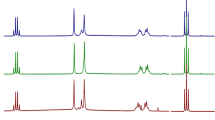Abstract
Prazosin, an antihypertensive drug with postsynaptic α1-aradrenergic blocking activity, has been coupled to poly-N 5-(3-hydroxypropyl-L-glutamine) (PHPG) via a carbamate linkage. PHPG was activated by p-nitrophenyl chloroformate and then reacted with prazosin to form p(HPG-prazosin carbamate) conjugate. Drug loading was 23.9% (w/w). Activated polymer and conjugates were characterized by infrared spectroscopy and differential scanning calorimetry. In vitro studies proceeded in pH 7.4 isotonic phosphate-buffered saline solution. Prazosin was released at a rate of 0.92 mg/day/100 mg conjugate from p(HPG-prazosin carbamate) particles. In vivo studies were performed with New Zealand White rabbits. P(HPG-prazosin carbamate) conjugate particles (100 mg) were suspended in 2 ml saline and injected subcutaneously into both flanks of rabbits. P(HPG-prazosin carbamate) conjugates, following an initial burst, demonstrated a nearly constant plasma prazosin concentration profile above 2 ng/ml, which was maintained for 10 days.
Similar content being viewed by others
REFERENCES
J. Vincent, P. A. Meredith, J. L. Reid, H. L. Elliott, and P. C. Rubin. Clinical pharmacokinetics of prazosin-1985. Clin. Pharmacokin. 10:144–154 (1985).
T. Tomiyama, I. Tomiyama, and M. Sato. Prazosin transdermal formulation. Chem. Abstr. 105:232471u (1986).
A. Kato, Y. Ishibashi, and Y. Miyake. Transdermal formulations containing guinazoline derivatives as antihypertensives. Chem. Abstr. 106:107916n (1987).
T. Nara, Y. Nishinomiya, T. Hatori, and S. Senda. Sustained-release pharmaceutical containing prazosin. Chem. Abstr. 107:242639k (1987).
L. Dei Cas, M. Metra, R. Danesi, S. Nodari, T. Guaini, R. Raddino, and P. E. Ghirardi. Steady state pharmacokinetics of a new slow-release preparation of prazosin. Curr. Ther. Res. 44:275–277 (1988).
N. Kurosawa, E. Owada, K. Ito, K. Ueda, S. Shinmatsu, T. Umeki, M. Fuse, and T. Murakami. Preparations of prazosin hydrochloride suppositories as a hospital pharmacy manufactured product. Chem. Abstr. 105:66386y (1986).
H. L. Elliott, J. Vincent, P. A. Meredith, and J. L. Reid. Relationship between plasma prazosin concentration and α-antagonism in humans: Comparison of conventional and rate-controlled (Oros) formulations. Clin. Pharmacol. Ther. 43:582–587 (1988).
J. Feijen, D. Gregonis, C. Anderson, R. V. Petersen, and J. Anderson. Coupling of steroid hormones to biodegradable poly(α-amino acids). I. Norethindrone coupled to poly-N5-(3-hydroxypropyl)-L-glutamine. J. Pharm. Sci. 69:871–872 (1980).
N. Negishi, D. B. Bennett, C.-S. Cho, S. Y. Jeong, W. A. R. Van Heeswijk, J. Feijen, and S. W. Kim. Coupling of naltrexone to biodegradable poly(α-amino acids). Pharm. Res. 4:305–310 (1987).
D. B. Bennett, N. W. Adams, X. Li, and S. W. Kim. Drugcoupled poly(amino acids) as polymeric prodrugs. J. Bioact. Compat. Polym. 3:44–52 (1988).
T. Hayashi, Y. Tabata, and A. Nakajima. Biodegradation of poly(α-amino acid) in vitro. Polymer J. 17:463–471 (1985).
F. Rypacek, V. Saudek, J. Pytela, V. Skarda, and J. Drobnik. Polyglutamines-Versatile biodegradable carriers. Makromol. Chem. Suppl. 9:129–135 (1985).
N. Minoura, S. Aiba, and Y. Fujiwara. Copolymer matrices composed of L-leucine and N5-(3-hydroxypropyl)-L-glutamine as carrier of drugs. Makromol. Chem. Rapid Commun. 5:643–648 (1984).
E. T. Lin, R. A. Baughman, Jr., and L. Z. Benet. High-performance liquid chromatographic determination of prazosin in human plasma, whole blood and urine. J. Chromatogr. 183:367–371 (1980).
R. K. Bhamra, R. J. Flanagan, and D. W. Holt. High-performance liquid chromatographic measurement of prazosin and terazosin in biological fluids. J. Chromatogr. 380:216–221 (1986).
J. F. Kinstle and H. Farah. Hydrolysis susceptibilities of urethane groups as a function of their microenvironment. Polymer Mater. Sci. Eng. 49:174–177 (1983).
K. Ernst-Cabrera and M. Wilchek. Silica containing primary hydroxyl groups for high-performance affinity chromatography. Anal. Biochem. 159:267–272 (1986).
K. Ernst-Cabrera and M. Wilcheck. Coupling of ligands to primary hydroxyl-containing silica for high-performance affinity chromatography. J. Chromatogr. 397:187–196 (1987).
M. Wilchek and T. Miron. Immobilization of enzymes and affinity ligands onto agarose via stable and uncharged carbamate linkages. Biochem. Int. 4:629–635 (1982).
D. N. Bateman, D. C. Hobbs, T. M. Twomey, E. A. Stevens, and M. D. Rawlins. Prazosin, pharmacokinetics and concentration effect. Eur. J. Clin. Pharmacol. 16:177–181 (1979).
C. A. Hamilton, J. L. Reid, and J. Vincent. Pharmacokinetic and pharmacodynamic studies with two α-adrenoceptor antagonists, doxazosin and prazosin in the rabbit. Br. J. Pharmacol. 86:79–87 (1985).
J. Vincent, C. A. Hamilton, and J. L. Reid. The cardiovascular effects of trimazosin and prazosin in the rabbit. Clin. Exp. Pharmacol Physiol. 13:593–608 (1986).
V. Menkin. Studies on inflammation. X. The cytological picture of an inflammatory exudate in relation to its hydrogen ion concentration. Am. J. Pathol. 10:193–210 (1934).
G. E. Zaikov. Quantitative aspects of polymer degradation in the living body. J. Macromol. Sci. C25:551–597 (1985).
Author information
Authors and Affiliations
Rights and permissions
About this article
Cite this article
Li, X., Adams, N.W., Bennett, D.B. et al. Synthesis of Poly(Hydroxypropylglutamine-Prazosin Carbamate) and Release Studies. Pharm Res 8, 527–530 (1991). https://doi.org/10.1023/A:1015819715867
Issue Date:
DOI: https://doi.org/10.1023/A:1015819715867




